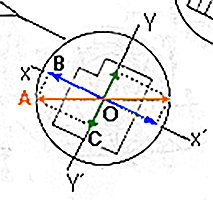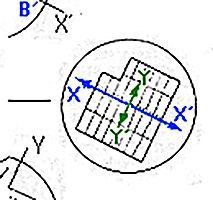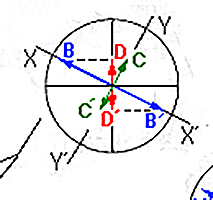
Interference colour. How is it formed?
5 polariser + anisotropic mineral (general case) + analyser
5.3 Interference of waves = n landa

In the right part of the figure, the waves have been drawn travelling perpendicularly to the screen.
It is assumed that the fast component of the crystal vibrates in the direction XX', whilst YY' represents the slow component. The phase difference is landa (or a whole number of wave-lengths).
The phase difference = 1 landa
The phase difference = 1 landa (or a whole number of wave-lengths) is equivalent to going up from 1 to 2, returning to the centre 3, dropping to 4 and returning to the centre 5. The space between 1 and 5 in the left part of the diagram is a landa.
 FROM POLARISER TO CRYSTAL
FROM POLARISER TO CRYSTAL
The wave from the polariser (horizontal in the diagram) is represented by the vector OW. This wave will divide in the two directions of vibration permitted in the crystal (XX´ and YY´), represented by the vectors OB and OC.
 TWO WAVES IN THE CRYSTAL
TWO WAVES IN THE CRYSTAL
The phase difference 1 landa means that on leaving the crystal, the wave XX' will be 1 landa ahead of YY', i.e. the space shown in movie (the space between 1 and 5).
When both waves divide in the plane of vibration of the analyser, two components of equal magnitude will be created vibrating in the same plane but in opposite directions. The result will thus be a negative interference, i.e. they will be annulled.
 TWO WAVES IN THE ANALYSER
TWO WAVES IN THE ANALYSER
The phase difference 1 landa is show in the movie.
This phase difference l landa is equivalent to going up
from 1 to 2, returning to the centre 3, dropping to 4 and returning to the
centre 5. When wave XX' reaches point 5, it will continue to vibrate up
to point 6 whilst YY' will go to 2Y.
Index | Introduction | PPL | XPL ortos | Interf colour | Int. c. formed? | Previous | Next | Top